Earthly Cycles
As you have probably noticed, the Sun rises and sets at different times and in different places in a cycle that repeats itself each year. Similarly, the Moon rises and sets at different times each day and repeats its cycle roughly once every 29½ days. Furthermore, as noted in Section 1-2, we do not see the same constellations up in the sky every night of the year, but the cycle of constellations we can see at night repeats each year. The daily and annual rhythms of the sky, Earth, and all life on it arise from three celestial motions:
 Earth’s spinning, which causes day and night, as well as causing the apparent daily motion of the celestial sphere and all the objects on it.
Earth’s spinning, which causes day and night, as well as causing the apparent daily motion of the celestial sphere and all the objects on it. Earth’s orbit around the Sun, which creates the seasons, the year, and the change in times at which constellations are up at night.
Earth’s orbit around the Sun, which creates the seasons, the year, and the change in times at which constellations are up at night. The Moon’s orbit around Earth, which creates the lunar phases, the cycle of tides, and the spectacular phenomena we call eclipses.
The Moon’s orbit around Earth, which creates the lunar phases, the cycle of tides, and the spectacular phenomena we call eclipses.
1-6 Earth’s rotation creates the day-night cycle and its revolution defines a year
Margin Question 1-2
Question
Why are asterisms like the Big Dipper sometimes seen upright and sometimes upside down?
Earth spins on its axis. Such motion is called rotation. We do not feel Earth’s rotation because our planet is so physically large compared to us that Earth’s gravitational attraction holds us firmly on its surface. Earth’s rotation causes the stars—as well as the Sun, the Moon, and planets—to appear to rise along the eastern horizon, move across the sky, and set along the western horizon. Earth’s daily rotation, causing the Sun to rise and set, thereby creates day and night. In general, this rotation creates diurnal motion, or daily motion, which causes all objects to circle around the celestial poles.
Consider taking a friend outside on a clear, warm night to observe the diurnal motion of the stars for yourselves. Soon after dark, find a spot away from bright lights, and note the constellations in the sky relative to some prominent landmarks near you on Earth. A few hours later, check again from the same place. You will find that the entire pattern of stars (as well any visible planets and the Moon, if it is up) has shifted and the orientations (angles in the sky) of all the asterisms will have changed. New constellations will have risen above the eastern horizon, while other constellations will have disappeared below the western horizon. If you check again just before dawn, you will find that the stars that were just rising in the east when the night began are now low in the western sky.
While rotation is the spinning of an astronomical object around an axis through it, revolution is the motion of any astronomical object around another astronomical object. Earth takes 1 year, or about 365¼ days, to revolve around the Sun. A year on Earth is measured by the motion of our planet relative to the stars. For example, draw a straight line from the Sun through Earth to some star on the opposite side of Earth from the Sun. As Earth revolves, that line inscribes a straight path on the celestial sphere (namely, the ecliptic) and returns to the original star 365¼ days later. The length of any cycle of motion measured with respect to the stars is called a sidereal period. For example, Earth’s annual orbit around the Sun, 1 year, is a sidereal period, as is the period of the diurnal motion of the stars each day in our sky 23 h 56 m 4 s.
Insight Into Science: Define Your Terms
As with interpersonal communication, using the correct words is very important in science. Usually, scientific words each have a specific meaning, such as “rotation” denoting spin and “revolution” meaning one object orbiting another. Be especially careful to understand the context in which words with more than one meaning, such as “ecliptic” and “constellation,” are used.
Different constellations are visible at night during different times of the year because of Earth’s revolution around the Sun. If Earth were rotating over a fixed place on the Sun, rather than revolving around it, then every star would always rise and set at the same time every day. Of course, Earth is in motion around the Sun, and as a result the Sun moves around the celestial sphere and the stars rise approximately 4 minutes earlier each day than they did the day (or night) before. This effect accumulates, bringing different constellations up at night throughout the year. Figure 1-10 summarizes this motion. When the Sun is within the boundaries of (colloquially, “in”) Virgo (September 18–November 1), for example, the hemisphere containing the Sun and the constellations around Virgo are in daylight (see Figure 1-10a). When the Sun is up, so are Virgo and the surrounding constellations, so we cannot see them. During that time of year, the constellations on the other side of the celestial sphere, centered on the constellation Pisces, are in darkness. Thus, when the Sun is “in” Virgo, Pisces and the constellations around it are high in our sky at night.

17
Six months later, when the Sun is “in” Pisces, that half of the sky is filled with daylight, while Virgo and the constellations around it are high in the night sky (see Figure 1-10b). These arguments apply everywhere on Earth at the same time because the Sun moves along its path very slowly as seen from Earth, taking a year to make one complete circuit around the celestial sphere.
We spoke earlier of stars rising on the eastern horizon and setting on the western horizon. Depending on your latitude, some of the stars and constellations never disappear below the horizon. Instead, they trace complete circles in the sky over the course of each night (Figure 1-11). To understand why this happens, imagine that you are standing on Earth’s North Pole at night. Looking straight up, you see Polaris. Because Earth is spinning around its axis directly under your feet, all the stars appear to move from left to right in horizontal rings above you. The exception is Polaris, which always remains at the North Pole’s zenith. As seen from the North Pole, no stars rise or set (Figure 1-12). They just seem to revolve around Polaris in horizontal circles. Stars and constellations that never go below the horizon as seen from a given place on Earth are called circumpolar (Figure 1-11). While there is no bright South Pole star equivalent to Polaris, all stars seen from the South Pole are also circumpolar and move from right to left.
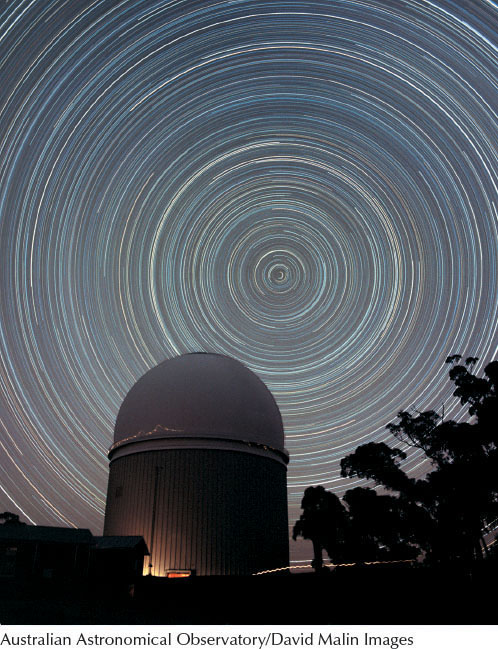

18
If you live in the northern hemisphere, Polaris is always located above your northern horizon at an angle equal to your latitude. Only the stars and constellations that pass between Polaris and the land directly below it are circumpolar. As you go farther south in the northern hemisphere, the number of stars and constellations that are circumpolar decreases. Likewise, as you go farther north in the southern hemisphere, the number of stars and constellations that are circumpolar decreases.
Now visualize yourself at the equator. All the stars appear to rise straight up in the eastern sky and set straight down in the western sky (Figure 1-13). Polaris is barely visible on the northern horizon. While Polaris never sets, all the other stars do, and therefore none of the stars are circumpolar as seen from the equator.

As you can see from these last two mental exercises, the angle at which the stars rise and set depends on your viewing latitude. Figure 1-14 shows stars setting at 35° north latitude. Polaris is fixed at 35° above the horizon to the right of this figure, not at the zenith, as it is at the North Pole, nor on the horizon, as seen from the equator. As another example, except for those stars in the corners, all the stars whose paths are shown in Figure 1-11 are circumpolar because they are visible all night, every night.
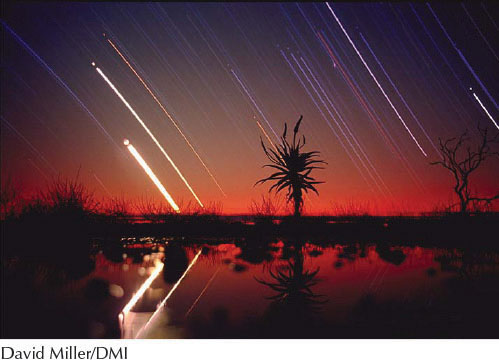
19
1-7 The seasons result from the tilt of Earth’s rotation axis combined with Earth’s revolution around the Sun
Most people are keenly aware of the changing seasons, which are commonly associated with two major cycles: changing temperatures and the changing number of daylight hours. We link summer with more hours of daylight and winter with fewer. This is not an accident and here we will explore the connection.
Equinoxes and Solstices
As we have seen, the ecliptic and the celestial equator are different circles tilted 23½° with respect to each other on the celestial sphere. This occurs because Earth’s rotation axis is tilted 23½° away from a line perpendicular to the ecliptic (Figure 1-15 and see Figure 1-9). These two circles intersect at only two points, which are exactly opposite each other on the celestial sphere (Figure 1-16 and see Figure 1-8a). Each of these two points is called an equinox (from the Latin words meaning “equal night”), because when the Sun appears at either point, it is directly over Earth’s equator, resulting in 12 hours of daytime and 12 hours of nighttime everywhere on Earth on that day.
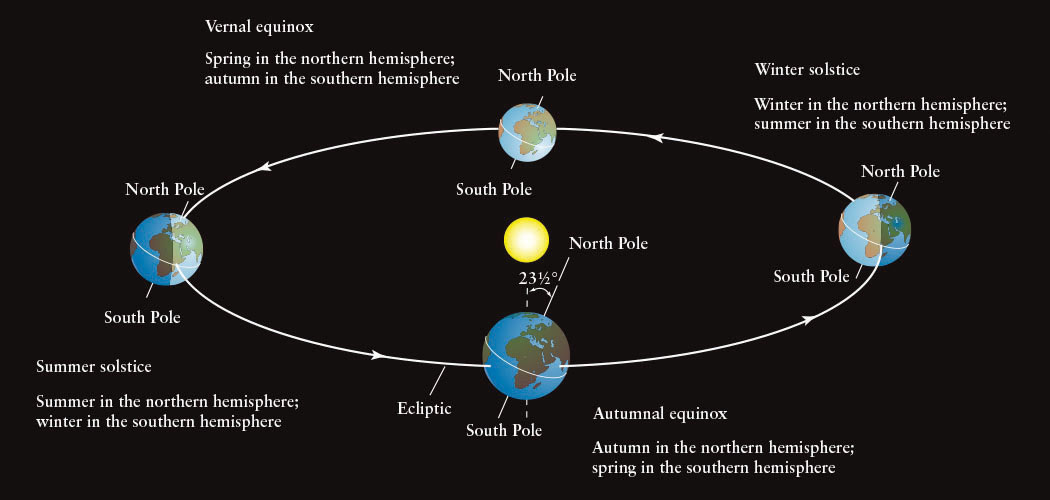
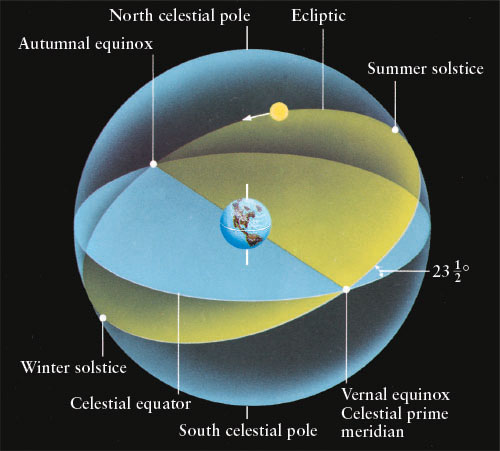
 The Seasons Are Linked to Equinoxes and Solstices The ecliptic is inclined to the celestial equator by 23½° because of the tilt of Earth’s axis of rotation. The ecliptic and the celestial equator intersect at two points called the equinoxes. The northernmost point on the ecliptic is called the summer solstice; the southernmost point is called the winter solstice.
The Seasons Are Linked to Equinoxes and Solstices The ecliptic is inclined to the celestial equator by 23½° because of the tilt of Earth’s axis of rotation. The ecliptic and the celestial equator intersect at two points called the equinoxes. The northernmost point on the ecliptic is called the summer solstice; the southernmost point is called the winter solstice.
Except for tiny changes each year, Earth maintains this tilted orientation as it orbits the Sun. Therefore, Polaris is above the North Pole throughout the year. For half the year, the northern hemisphere is tilted toward the Sun, and as a result, the Sun rises higher in the northern hemisphere’s sky than it does during the other half of the year (Figure 1-17). Equivalently, when the southern hemisphere is tilted toward the Sun, the Sun rises higher in the southern hemisphere’s sky.

Consider the location of the Sun throughout the year as seen from the northern hemisphere. (The caption for Figure 1-17 carries the appropriate adjustments for the southern hemisphere. For the following paragraphs in the southern hemisphere, add 6 months to each date, and change winter to summer, spring to fall, north to south.) The day that the Sun rises farthest south of east is around December 22 each year (Figure 1-17a) and is called the winter solstice. The winter solstice is the point on the ecliptic farthest south of the celestial equator (see Figure 1-16). It is also the day when the Sun rises to the lowest height at noon (Figure 1-17a), and it signals the day of the year in the northern hemisphere with the fewest number of daylight hours.
Margin Question 1-3
Question
Explain why Figure 1-14 must have been taken facing west. Hint: Examine Figure 1-17.
20
As the Sun moves along the ecliptic after the winter solstice, it rises earlier, is more northerly on the eastern horizon, and it passes higher in the sky at midday than it did on preceding days. Three months later, around March 20, the Sun crosses the celestial equator heading northward. As noted in Section 1-5, this is called the vernal equinox and is one of the two days on which the Sun rises due east and sets due west (Figure 1-17b). The vernal equinox is the “prime meridian” of the celestial sphere. Three months after the vernal equinox, around June 21, the Sun rises farthest north of east and passes highest in the sky (Figure 1-17c). This is the summer solstice (see Figure 1-16), the day of the year in the northern hemisphere with the most daylight.
21
From June 21 through December 21, the Sun rises farther south than it did the preceding day. Its highest point in the sky is lower each succeeding day—the cycle of the previous 6 months reverses. The autumnal equinox occurs around September 22 (Figure 1-17d), with the Sun heading southward across the celestial equator, as seen from Earth.
The Seasons
The higher the Sun rises during the day, the more daylight hours there are. During the days with longer periods of daylight, more light and heat from the Sun strike that hemisphere. Furthermore, when the Sun is higher in the sky, its energy is more concentrated on Earth’s surface (see the footprint that the “cylinder of light” from the Sun makes in Figure 1-17a–d). Thus, during these days more energy is deposited on each square meter of the surface, thereby warming the surface more than when the Sun is lower in the sky. The temperature and, hence, the seasons are determined by the duration of daylight at any place and the height of the Sun in the sky there. (Bear in mind that winds and clouds greatly affect the weather throughout the year—we ignore these effects here.)
 To summarize, the Sun is lowest in the northern sky on the winter solstice. This marks the beginning of winter in the northern hemisphere. As the Sun moves northward, the amount of daylight and heat deposited increases daily. The vernal equinox marks a midpoint in the amount of light and heat from the Sun onto the northern hemisphere and is the beginning of spring. When the Sun reaches the summer solstice, it is highest in the northern sky and is above the horizon for the most hours of any day of the year. This is the beginning of summer. Returning southward, the Sun crosses the celestial equator once again on the autumnal equinox, the beginning of fall.
To summarize, the Sun is lowest in the northern sky on the winter solstice. This marks the beginning of winter in the northern hemisphere. As the Sun moves northward, the amount of daylight and heat deposited increases daily. The vernal equinox marks a midpoint in the amount of light and heat from the Sun onto the northern hemisphere and is the beginning of spring. When the Sun reaches the summer solstice, it is highest in the northern sky and is above the horizon for the most hours of any day of the year. This is the beginning of summer. Returning southward, the Sun crosses the celestial equator once again on the autumnal equinox, the beginning of fall.
 Earth is closest to the Sun on or around January 3 of each year—the dead of winter in the northern hemisphere! While the distance between Earth and the Sun changes by 5 million km (3 million mi) throughout the year, this 3% variation in distance has only a minor effect on the seasons. The variation in Earth’s distance from the Sun over the year would have a greater effect if it were not for the fact that the southern hemisphere has more area covered by oceans than does the northern hemisphere. Water absorbs less heat from the Sun than does land. As a result, when Earth is closer to the Sun during the southern hemisphere’s summer (and hence the Sun is high in the southern hemisphere’s sky), the southern oceans scatter more light and heat directly back into space than occurs when the Sun is higher over the land-rich northern hemisphere during the other half of the year. Had the extra energy sent back into space when we are closer to the Sun been absorbed by our planet, Earth would indeed heat more during this time than when the Sun is over the northern hemisphere.
Earth is closest to the Sun on or around January 3 of each year—the dead of winter in the northern hemisphere! While the distance between Earth and the Sun changes by 5 million km (3 million mi) throughout the year, this 3% variation in distance has only a minor effect on the seasons. The variation in Earth’s distance from the Sun over the year would have a greater effect if it were not for the fact that the southern hemisphere has more area covered by oceans than does the northern hemisphere. Water absorbs less heat from the Sun than does land. As a result, when Earth is closer to the Sun during the southern hemisphere’s summer (and hence the Sun is high in the southern hemisphere’s sky), the southern oceans scatter more light and heat directly back into space than occurs when the Sun is higher over the land-rich northern hemisphere during the other half of the year. Had the extra energy sent back into space when we are closer to the Sun been absorbed by our planet, Earth would indeed heat more during this time than when the Sun is over the northern hemisphere.
WHAT IF…: Earth’s changing distance from the Sun caused the seasons (and how do we know it doesn’t)?
Earth’s orbit around the Sun is elliptical (we will discuss this oval shape in detail in Chapter 2). If the seasons were caused by the changing distance between Earth and the Sun, all parts of Earth should have the same seasons at the same time. In fact, the northern and southern hemispheres have seasons at exactly opposite times, so they must be caused by something else.
Insight Into Science: Expect the Unexpected
The process of science requires that we question the obvious, that is, what we think we know. Many phenomena in the universe defy commonsense explanations. The fact that the changing distance from Earth to the Sun has a minimal effect on the seasons is an excellent example.
The Sun’s Path Across the Sky
During the northern hemisphere’s summer months, when the northern hemisphere is tilted toward the Sun (see Figure 1-15), the Sun rises in the northeast and sets in the northwest. The Sun provides more than 12 hours of daylight in the northern hemisphere and passes high in the sky. At the summer solstice, the Sun is as far north as it gets, giving the greatest number of daylight hours to the northern hemisphere (Figure 1-17c).
During the northern hemisphere’s winter months, when the northern hemisphere is tilted away from the Sun, the Sun rises in the southeast. Daylight lasts for fewer than 12 hours, as the Sun skims low over the southern horizon and sets in the southwest. Night is longest in the northern hemisphere when the Sun is at the winter solstice (Figure 1-17a).
The Sun’s maximum angle above the southern horizon is different at different latitudes. The farther north you are, the lower the Sun is in the sky at any time of day than it is on that day at more equatorial locations. At latitudes above 66½° north latitude or below 66½° south latitude, the Sun does not rise at all during parts of their fall and winter months. During their spring and summer months, those same regions of Earth have continuous sunlight for weeks or months (Figure 1-18) because the Sun is then circumpolar; hence, the name “Land of the Midnight Sun.”

Margin Question 1-4
Question
What region of Earth has the smallest range of seasonal temperature changes and why?
22
 The Sun takes 1 year to complete a trip around the ecliptic (as noted above, this motion is actually caused by Earth’s orbit around the Sun). Since there are about 365¼ days in a year and 360° in a circle, the Sun appears to move along the ecliptic at a rate of slightly less than 1° per day. The constellations through which the Sun moves throughout the year as it travels along the ecliptic are called the zodiac constellations. We cannot see the stars of these constellations when the Sun is among them (see Figure 1-10), but we can plot the Sun’s path on the celestial sphere to determine through which constellations it moves. Traditionally, there were 12 zodiac constellations whose borders were set in antiquity. In 1930, the boundaries of the constellations were redefined by astronomers, and the Sun now moves through 13 constellations throughout the year. (The thirteenth zodiac constellation is Ophiuchus the Serpent Holder. The Sun passes through Ophiuchus from December 1 to December 19 each year.) Table 1-1 lists all the zodiac constellations and the dates the Sun passes through them. You may not have the “sign” that you think you have.
The Sun takes 1 year to complete a trip around the ecliptic (as noted above, this motion is actually caused by Earth’s orbit around the Sun). Since there are about 365¼ days in a year and 360° in a circle, the Sun appears to move along the ecliptic at a rate of slightly less than 1° per day. The constellations through which the Sun moves throughout the year as it travels along the ecliptic are called the zodiac constellations. We cannot see the stars of these constellations when the Sun is among them (see Figure 1-10), but we can plot the Sun’s path on the celestial sphere to determine through which constellations it moves. Traditionally, there were 12 zodiac constellations whose borders were set in antiquity. In 1930, the boundaries of the constellations were redefined by astronomers, and the Sun now moves through 13 constellations throughout the year. (The thirteenth zodiac constellation is Ophiuchus the Serpent Holder. The Sun passes through Ophiuchus from December 1 to December 19 each year.) Table 1-1 lists all the zodiac constellations and the dates the Sun passes through them. You may not have the “sign” that you think you have.
| Constellation | Dates of the Sun’s passage through each |
|---|---|
| Pisces | March 13–April 20 |
| Aries | April 20–May 13 |
| Taurus | May 13–June 21 |
| Gemini | June 21–July 20 |
| Cancer | July 20–August 11 |
| Leo | August 11–September 18 |
| Virgo | September 18–November 1 |
| Libra | November 1–November 22 |
| Scorpius | November 22–December 1 |
| Ophiuchus | December 1–December 19 |
| Sagittarius | December 19–January 19 |
| Capricorn | January 19–February 18 |
| Aquarius | February 18–March 13 |
1-8 Clock times based on the Sun’s location created scheduling nightmares
The Sun’s daily motion through the sky provided our distant ancestors’ earliest reference for time because the Sun’s location determines whether it is day or night and roughly whether it is before or after midday. The Sun’s motion through the sky came to determine the length of the solar day, upon which our 24-hour day is based. Ideally, this is the interval of time between when the Sun is highest in the sky on one day until the time it is highest in the sky on the next day. However, the length of the solar day actually varies throughout the year, up to 30 seconds per day. This occurs because Earth’s orbit around the Sun is not perfectly circular—our planet’s speed along the ecliptic increases as we approach the Sun and it decreases as we move away from it—and because Earth’s rotation axis is tilted 23½° from being perpendicular to the ecliptic. These two effects change the apparent speed of the Sun across the sky from day to day. The average time interval between consecutive noontimes throughout the year is 24 hours, which determines the time we use on our clocks. This is called the mean (or average) solar day.
Traditionally, noontime was taken to be the instant when the Sun is highest in the sky. But as we have just seen, the interval from one noontime to the next is not exactly 24 hours, so the Sun is not always highest at noon. The difference between clock noontime and astronomical noontime (when the Sun is highest) accumulates day by day during parts of the year until it is as much as 16 minutes. Of course, the difference then diminishes.
Because Earth is rotating eastward, the Sun is highest at different longitudes (measured east and west along lines running between Earth’s poles) at different times. For example, astronomical noon in New York City occurs earlier than it does a little farther west, in Philadelphia. Before the advent of time zones, local time was based on astronomical noon. To travel west from New York to Philadelphia by train, for example, you had to know the departure time in New York, using New York time, as well as the arrival time in Philadelphia (say, if someone was going to meet you) in Philadelphia time. Such time considerations became very confusing and burdensome as society grew more complex. Time zones were established in 1884 to alleviate this problem. In a time zone, everyone agrees to set their clocks to the same time. Time zones are based on the time at 0° longitude in Greenwich, England, a location called the prime meridian, as mentioned earlier. With some variations due to geopolitical boundaries, every 15° of longitude around the globe begins a new time zone. The resulting 24 time zones are shown in Figure 1-19. Going from one time zone to the next usually requires you to change the time on your wristwatch or cell phone by exactly 1 hour.
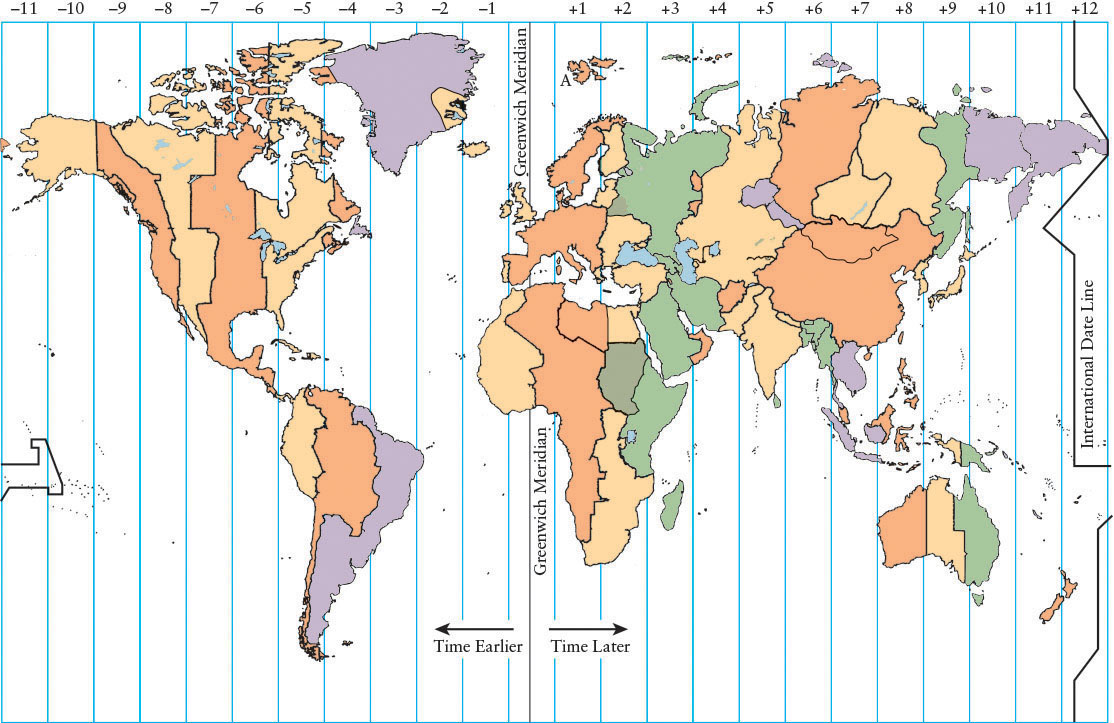
23
Along with the solar day, there is also a sidereal day, the length of time from when a star is in one place in the sky until it is next in the same place. The solar and sidereal days differ from each other in length because while Earth rotates, it also revolves around the Sun. This motion of Earth in its orbit day by day changes the location of the stars, bringing them back to their original positions 4 minutes earlier each day. Therefore, the sidereal day is 23 hours, 56 minutes, 4 seconds long while the solar day is 24 hours long (Figure 1-20).
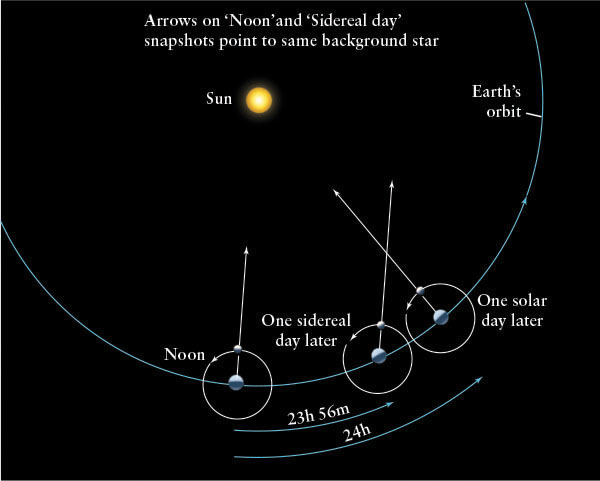
24
1-9 Calendars based on equal-length years also created scheduling problems
Margin Question 1-5
Question
Why would a calendar based on sidereal days not be satisfactory?
Just as the day is caused by Earth’s rotation, the year is the unit of time based on Earth’s revolution about the Sun. Earth does not take exactly 365 days to orbit the Sun, so the year is not exactly 365 days long. Basing the year on a 365-day cycle led to important events (such as holidays) occurring on the wrong day. To resolve this problem, Roman statesman Julius Caesar (100 b.c.e. – 44 b.c.e.) implemented a new calendar in the year 46 b.c.e. Because measurement revealed to ancient astronomers that the length of a year is approximately 365¼ days, this “Julian” calendar established a system of leap years to accommodate the extra quarter of a day. By adding an extra day to the calendar every 4 years, Caesar hoped to ensure that seasonal astronomical events, such as the beginning of spring, would occur on the same date year after year.
The Julian calendar would have worked just fine if a year were exactly 365¼ days long and if Earth’s rotation axis (currently pointing toward Polaris, as discussed earlier) never changed direction. However, neither assumption is correct. Thus, over time, a discrepancy accumulated between the calendar and the actual time—astronomical and cultural events continued to fall on different dates each year. To straighten things out, a committee established by Pope Gregory XIII (1502–1585) recommended a refinement, thus creating the Gregorian calendar in 1582. Pope Gregory began by dropping 10 days (October 5, 1582, was proclaimed to be October 15, 1582), which brought the first day of spring back to March 20. Next, he modified Caesar’s system of leap years. Caesar had added February 29 to every calendar year that is evenly divisible by four. In the Julian system, for example, 1700, 1800, 1900, and 2000 would all have been leap years with 366 days. But this system produces an error of about 3 days every four centuries. To solve the problem, Pope Gregory decreed that century years would be leap years only if evenly divisible by 400. For example, the years 1700, 1800, and 1900 were not leap years under the improved Gregorian system. But the year 2000—which can be divided evenly by 400—was a leap year. We use the Gregorian system today. It assumes that the year is 365.2425 mean solar days long, which is very close to the length of the tropical year, defined as the time interval from one vernal equinox to the next. In fact, the error is only 1 day in every 3300 years. That will not cause any problems for a long time.
1-10 Precession is a slow, circular motion of Earth’s axis of rotation
As just noted above, the orientation of Earth’s axis of rotation changes slightly with respect to the celestial sphere (that is, it “points” in a slightly different directions over time). While this change is small over our lifetimes, it eventually causes the north celestial pole to drift away from Polaris. This major change in orientation is caused by gravitational forces from the Moon and the Sun pulling on the slight bulge at Earth’s equator created by Earth’s rotation—our planet’s diameter is about 43 km (27 mi) greater at the equator than from pole to pole. Gravitation (gravity) is the universal force of attraction between all matter. The strength of the gravitational force between two objects depends on the amounts of mass the objects have and the distance between them, as we explain in more detail in Chapter 2.
Because of Earth’s tilted axis of rotation, the Sun and Moon are usually not located directly over Earth’s equator. As a result, their gravitational attractions on Earth’s equatorial bulge provide forces that pull the bulge toward them (Figure 1-21a). However, Earth does not respond to these forces from the Sun and Moon by tilting so that its equator is closest to them. Instead, Earth maintains the same tilt (23½° from the ecliptic), but the direction in which its axis of rotation points on the celestial sphere changes—a motion called precession. This is exactly the same behavior exhibited by a spinning top (Figure 1-21b). If the top were not spinning, gravity would pull it over on its side. But when it is spinning, the combined actions of gravity and rotation cause the top’s axis of rotation to precess or wobble in a circular path. As with the toy top, the combined actions of gravity from the Sun and the Moon plus rotation cause Earth’s axis to trace a circle in the sky while remaining tilted about 23½° away from the ecliptic.
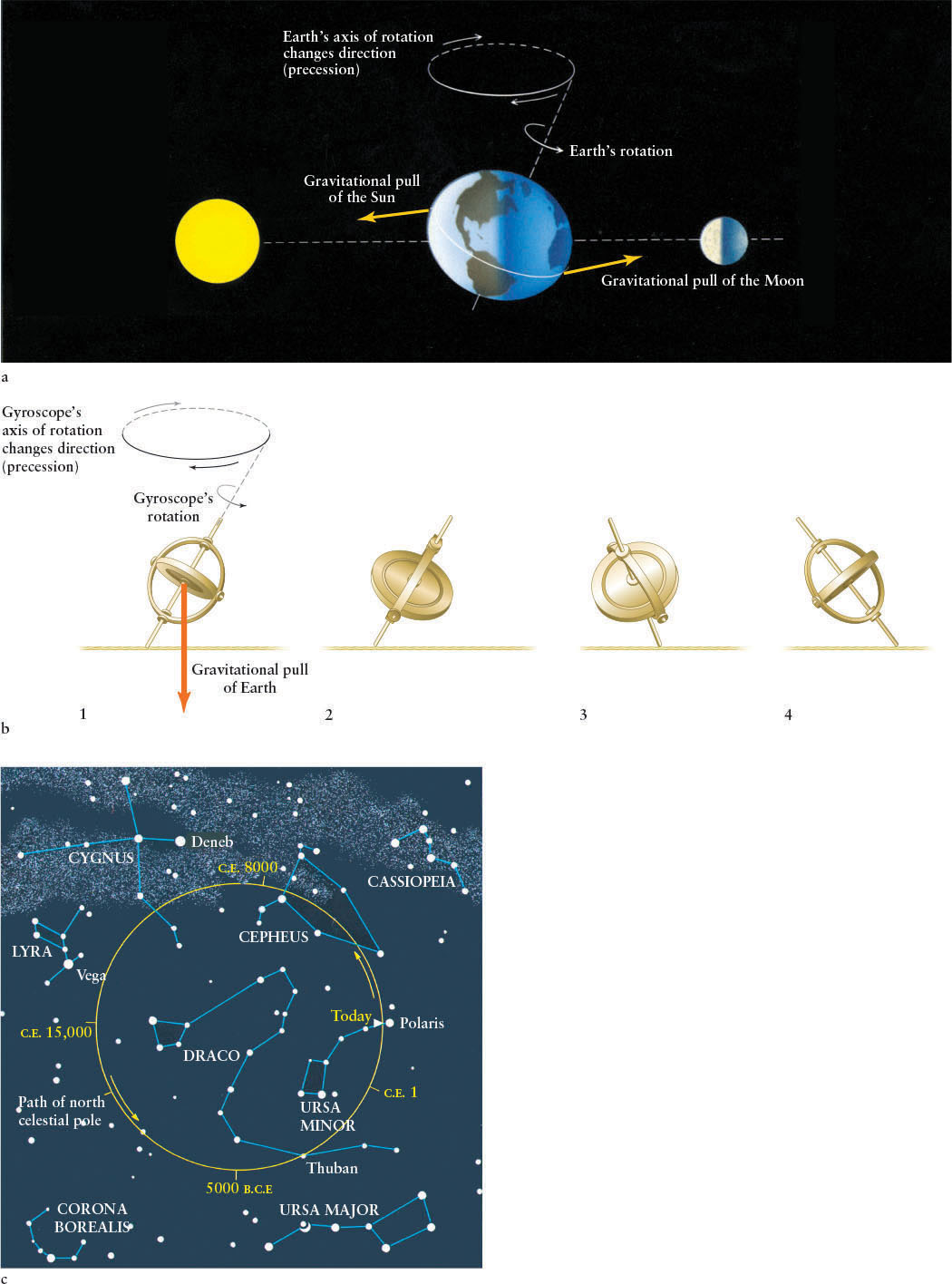
In the mid-1990s, astronomers simulated the behavior of Earth and discovered that without a large moon, Earth would not keep to a 23½° tilt, but rather would change its angle relative to the ecliptic dramatically over millions of years. Therefore, while being a major cause of precession, the Moon has played a crucial role in stabilizing Earth and maintaining the seasons as we know them.
Earth’s rate of precession is slow compared to human timescales. It takes about 26,000 years for the north celestial pole to trace out a complete circle around the sky, as shown in Figure 1-21c. (The south celestial pole executes a similar circle in the southern sky.) At the present time, Earth’s north axis of rotation points within 1° of the star Polaris. In 3000 b.c.e., it pointed near the star Thuban in the constellation Draco (the Dragon). In c.e. 14,000, the pole star will be near Vega in Lyra. As Earth’s axis of rotation precesses, its equatorial plane also moves. Because Earth’s equatorial plane defines the location of the celestial equator in the sky, the celestial equator also changes over time. Recall that the intersections of the celestial equator and the ecliptic define the equinoxes, so these key locations in the sky shift slowly from year to year. This entire phenomenon is often called the precession of the equinoxes. This change was discovered by the great Greek astronomer Hipparchus (190 b.c.e.–120 b.c.e.). Today, the vernal equinox is located in the constellation Pisces (the Fish). Two thousand years ago, it was located in Aries (the Ram). Around the year c.e. 2600, the vernal equinox will move into Aquarius (the Water Bearer).
25
26
1-11 The phases of the Moon originally inspired the concept of the month
While the Moon’s precessional effect on Earth unfolds over millennia, many lunar effects are noticeable every day. As the Moon orbits Earth, it moves from west to east (right to left) on the celestial sphere, changing position among the background stars. Its position relative to the Sun also changes, and, as a result, we see different lunar phases.
The Sun illuminates half of the Moon at all times (Figure 1-22). The Moon’s phase that we see depends on how much of its sunlit hemisphere is facing Earth. When the Moon is closest to the Sun in the sky, its dark hemisphere faces Earth. This phase, during which the Moon is at most a tiny crescent, is called the new Moon. During the 7 days following the new phase, more of the Moon’s illuminated hemisphere becomes exposed to our view, resulting in a phase called the waxing crescent Moon. At the first quarter Moon, we see half of the illuminated hemisphere and half of the dark hemisphere. “Quarter Moon” refers to how far in its cycle the Moon has gone, rather than what fraction of the Moon appears lit by sunlight.
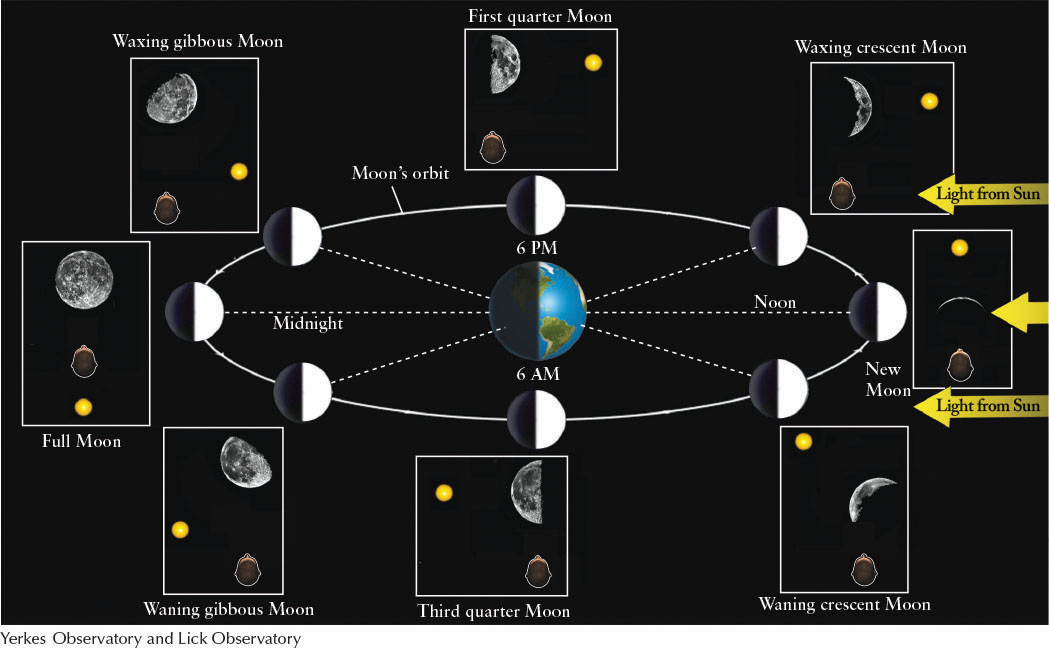
 The Phases of the Moon The diagram shows the Moon at eight locations on its orbit as viewed from far above Earth’s North Pole. Light from the Sun illuminates one-half of the Moon at all times, while the other half is dark. It takes about 29½ days for the Moon to go through all its phases. The inset drawings with photographs show the resulting lunar phases as seen from Earth.
The Phases of the Moon The diagram shows the Moon at eight locations on its orbit as viewed from far above Earth’s North Pole. Light from the Sun illuminates one-half of the Moon at all times, while the other half is dark. It takes about 29½ days for the Moon to go through all its phases. The inset drawings with photographs show the resulting lunar phases as seen from Earth.
During the next week, still more of the illuminated hemisphere can be seen from Earth, giving us the phase called the waxing gibbous Moon. “Gibbous” means “rounded on both sides.” When the Moon arrives on the opposite side of Earth from the Sun, we see virtually all of the fully illuminated hemisphere. This phase is the full Moon. Over the following 2 weeks, we see less and less of the illuminated hemisphere as the Moon continues along its orbit. This movement produces the phases called the waning gibbous Moon, the third quarter Moon, and the waning crescent Moon. The Moon completes a full cycle of phases in 29½ days.
 Confusion often occurs over the terms “far side” and “dark side” of the Moon. The far side is the side of the Moon facing away from Earth. The dark side is the side of the Moon on which the Sun is not shining. By examining the photographs in Figure 1-22, you can see that the same physical side of the Moon faces Earth all the time (that is, we always see the same craters). The half of the Moon that never faces Earth is the far side. However, the far side is not always the dark side, because we see part of the dark side whenever we see less than a full Moon. (What did Pink Floyd have to say about the dark side of the Moon?)
Confusion often occurs over the terms “far side” and “dark side” of the Moon. The far side is the side of the Moon facing away from Earth. The dark side is the side of the Moon on which the Sun is not shining. By examining the photographs in Figure 1-22, you can see that the same physical side of the Moon faces Earth all the time (that is, we always see the same craters). The half of the Moon that never faces Earth is the far side. However, the far side is not always the dark side, because we see part of the dark side whenever we see less than a full Moon. (What did Pink Floyd have to say about the dark side of the Moon?)
27
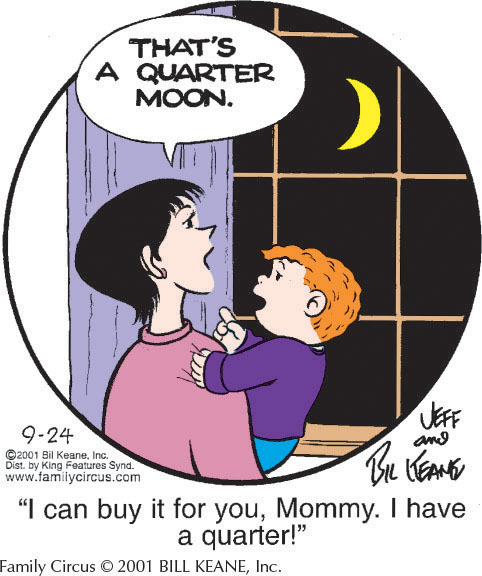
Figure 1-22 shows the Moon at various positions in its orbit. Remember that the bright side of the Moon is on the right (west) side of the waxing Moon, while the bright side is on the left (east) side of the waning Moon. This information can tell you at a glance whether the Moon is waxing or waning. When looking at the Moon through a telescope, the best place to see surface details is where the shadows are longest. This occurs at the boundary between the bright and dark regions, called the terminator.
 Figure 1-22 also shows local time around the globe, from noon, when the Sun is highest in the sky, to midnight, when it is on the opposite side of Earth. These time markings roughly indicate when the Moon is highest in the sky. For example, at first quarter, the Moon is 90° east of the Sun in the sky; hence, the Moon is highest at sunset. At full Moon, the Moon is opposite the Sun in the sky; thus, the Moon is highest at midnight. Using this information, you can see that the Moon is visible during the daytime (Figure 1-23) for a part of most days of the year.
Figure 1-22 also shows local time around the globe, from noon, when the Sun is highest in the sky, to midnight, when it is on the opposite side of Earth. These time markings roughly indicate when the Moon is highest in the sky. For example, at first quarter, the Moon is 90° east of the Sun in the sky; hence, the Moon is highest at sunset. At full Moon, the Moon is opposite the Sun in the sky; thus, the Moon is highest at midnight. Using this information, you can see that the Moon is visible during the daytime (Figure 1-23) for a part of most days of the year.
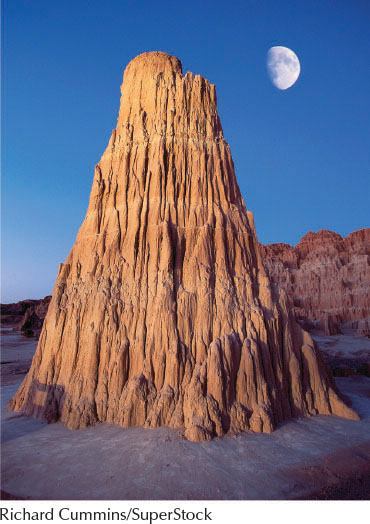
WHAT IF…: Mark Twain were right?
Mark Twain once wrote, “Everyone is a moon and has a dark side which he never shows to anybody.” Twain implies that the side of the Moon we don’t see is its dark side. But the dark side of an astronomical body is the side facing away from the Sun—the nighttime side of that world. If we never saw the Moon’s dark side, we would always see its sunlit side. That is, we would always see a full Moon. In any phase other than full, we see part or all of the Moon’s dark side.
Margin Question 1-6
Question
What phase does the Moon really have in the cartoon above?
Margin Question 1-7
Question
Is the Moon waning or waxing in Figure 1-23?
Since the dawn of civilization, people have sought accurate timekeeping systems. Ancient Egyptians wanted to know when the Nile would flood. Farmers everywhere needed to know when to plant crops. Migratory tribes wanted to know when the weather would change. Religious leaders scheduled observances in accordance with celestial events. Thus, astronomers have traditionally been responsible for telling time. Indeed, of the four ways in which time cycles are set, three are astronomical in origin: Time is determined by the positions of the Moon, Sun, or stars or, in our own age, by technological means, such as atomic clocks.
The approximately 4 weeks that the Moon takes to complete one cycle of its phases inspired our ancestors to invent the concept of a month. Astronomers find it useful to define two types of months, depending on whether the Moon’s motion is measured relative to the stars or to the Sun. Neither type corresponds exactly to the months of our usual calendar, which have different (and, in the case of February, varying) lengths.
28
The sidereal month is the time it takes the Moon to complete one full orbit of 360° around Earth (Figure 1-24). The length of the sidereal month is determined by the location of the Moon in its orbit around Earth as measured with respect to the stars. Equivalently, this is the time it takes the Moon to start at one place on the celestial sphere and return to exactly the same place again. The sidereal orbital period of the Moon takes approximately 27.3 days. The synodic month, or lunar month, is the time it takes the Moon to complete one 29½-day cycle of phases (for example, from new Moon to new Moon or from full Moon to full Moon) and thus is measured with respect to the Sun rather than the stars.
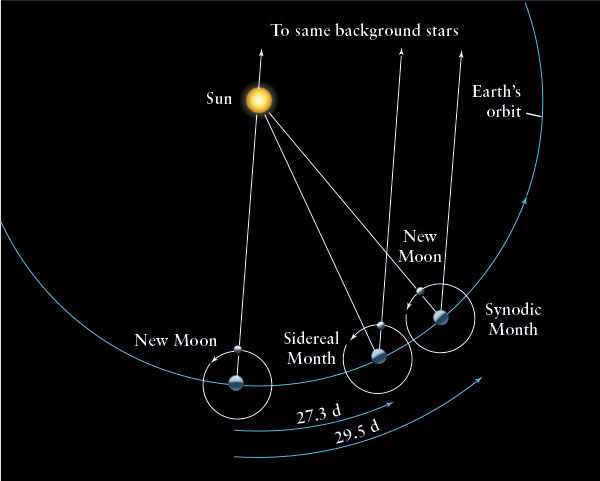
 The Sidereal and Synodic Months The sidereal month is the time it takes the Moon to complete one revolution with respect to the background stars, about 27.3 days. However, because Earth is constantly moving in its orbit about the Sun, the Moon must travel through more than 360° to get from one new Moon to the next. The synodic month is the time between consecutive new Moons or consecutive full Moons, about 29½ days.
The Sidereal and Synodic Months The sidereal month is the time it takes the Moon to complete one revolution with respect to the background stars, about 27.3 days. However, because Earth is constantly moving in its orbit about the Sun, the Moon must travel through more than 360° to get from one new Moon to the next. The synodic month is the time between consecutive new Moons or consecutive full Moons, about 29½ days.
The synodic month is longer than the sidereal month because Earth is orbiting the Sun while the Moon goes through its phases. As shown in Figure 1-24, the Moon must travel more than 360° along its orbit around Earth to complete a cycle of phases (for example, from one new Moon to the next), which takes about 2.2 days longer than the sidereal month.
Both the sidereal month and synodic month vary somewhat, because the gravitational pull of the Sun on Earth changes Earth’s orbital speed throughout the year and the gravitational pull of the Sun on the Moon affects the Moon’s speed as it orbits Earth. The sidereal month can vary by as much as 7 hours, while the synodic month can change by as much as 12 hours.
The terms synodic and sidereal are also used in discussing the motion of the other bodies in the solar system. The synodic period of a planet is the time between consecutive straight alignments of the Sun, Earth, and that planet (during which time interval the planet also goes through a cycle of phases, as seen from Earth). Recall that any orbit measured with respect to the stars is called “sidereal,” including orbits of the planets around the Sun, as well as orbits of moons around their planets.